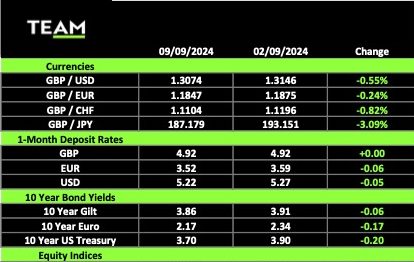Sponsored Content
Andrew Gillham, of Team Asset Management, offers this week’s market review
THERE was a sense of déjà vu as markets started September in much the same way they did in August, with concerns over the creaking US labour market and the exuberant valuations of some high-flying technology stocks weighing on investors’ minds.
The blue-chip S&P 500 and technology-focused Nasdaq indices fell 3.1% and 4.7% respectively.
A month ago, the disappointing Nonfarm Payrolls report for July was a key driver behind the early sell-off in stock markets before subsequent economic data releases helped to allay fears that the US economy was on the brink of recession. However, back-to-backto-back weaker-than-expected employment reports raised the risks of an economic downturn.
On Wednesday, the Labour Department’s Job Openings and Labour Turnover Survey revealed that job vacancies had shrunk to 7.7 million in July, the lowest level since January 2021 and well below analysts’ forecasts of 8.1 million.
The ADP and Nonfarm payrolls reports for August, released shortly afterwards, also painted a picture of a softening jobs market. The ADP survey revealed that companies had hired just 99,000 workers in the private sector, while an underwhelming 142,000 jobs were added according to the broader Nonfarm payrolls report.
Investors are also becoming increasingly concerned about a slowdown in China, the world’s second-largest economy, where confidence is waning that policymakers in Beijing can achieve the official economic growth target of around 5% this year, as its prolonged property slump weighs on consumer demand.
China’s development over the past few decades has fuelled demand for commodities to build its cities and infrastructure but the murkier growth outlook has hit some industrial metals, including copper and iron, hard.
Just four months ago, analysts at Goldman Sachs predicted that the price of copper, a key material for the green transition, would hit a record high of $15,000 a tonne next year but last week they changed course and cut their price forecast to $10,100 owing to the weakness in the country’s property sector. Meanwhile, the iron-ore price slumped to a two-year low of $87 a tonne.
The price of oil has also continued to slide on concerns over weaker demand from China, the world’s largest importer of crude oil. Brent crude fell to $71 a barrel last week, its lowest level since November 2021. Historically, supply risks from geopolitical tensions in the Middle East have supported the oil price, but this time around markets are more focused on the demand outlook. The Opec+ cartel’s decision on Thursday to extend its production cuts for at least the next two months was widely expected and had little impact on prices.
In company news, shares in Nvidia, the poster child of the AI rally this year, fell 14% last week after it was reported that the US Justice Department is investigating the company for evidence that it has breached competition laws.
Authorities are concerned that the chipmaker is making it more difficult for customers to switch to other suppliers and penalising buyers than don’t exclusively use its AI chips.
While the slump wiped more than $400 billion off Nvidia’s market valuation, its shares have more than doubled since the start of the year.
Apple was another high-profile technology company in the news ahead of the unveiling of its new iPhone range on Monday. Chief executive Tim Cook asserted that the iPhone 16 had been designed from the ground up for AI but the initial reaction from investors was relatively muted, as some analysts questioned whether there are enough new features to persuade consumers to upgrade their devices.
In the week ahead, investors will be looking for central banks to give markets a boost. The European Central Bank will announce its interest rate decision at lunchtime tomorrow, and a 0.25% reduction in its deposit rate to 3.5% is fully priced in with inflation continuing to slow across the Eurozone. ECB president Christine Lagarde’s press conference following the announcement of the decision will be closely watched for indications of the timing and pace of interest rate cuts further down the road.






